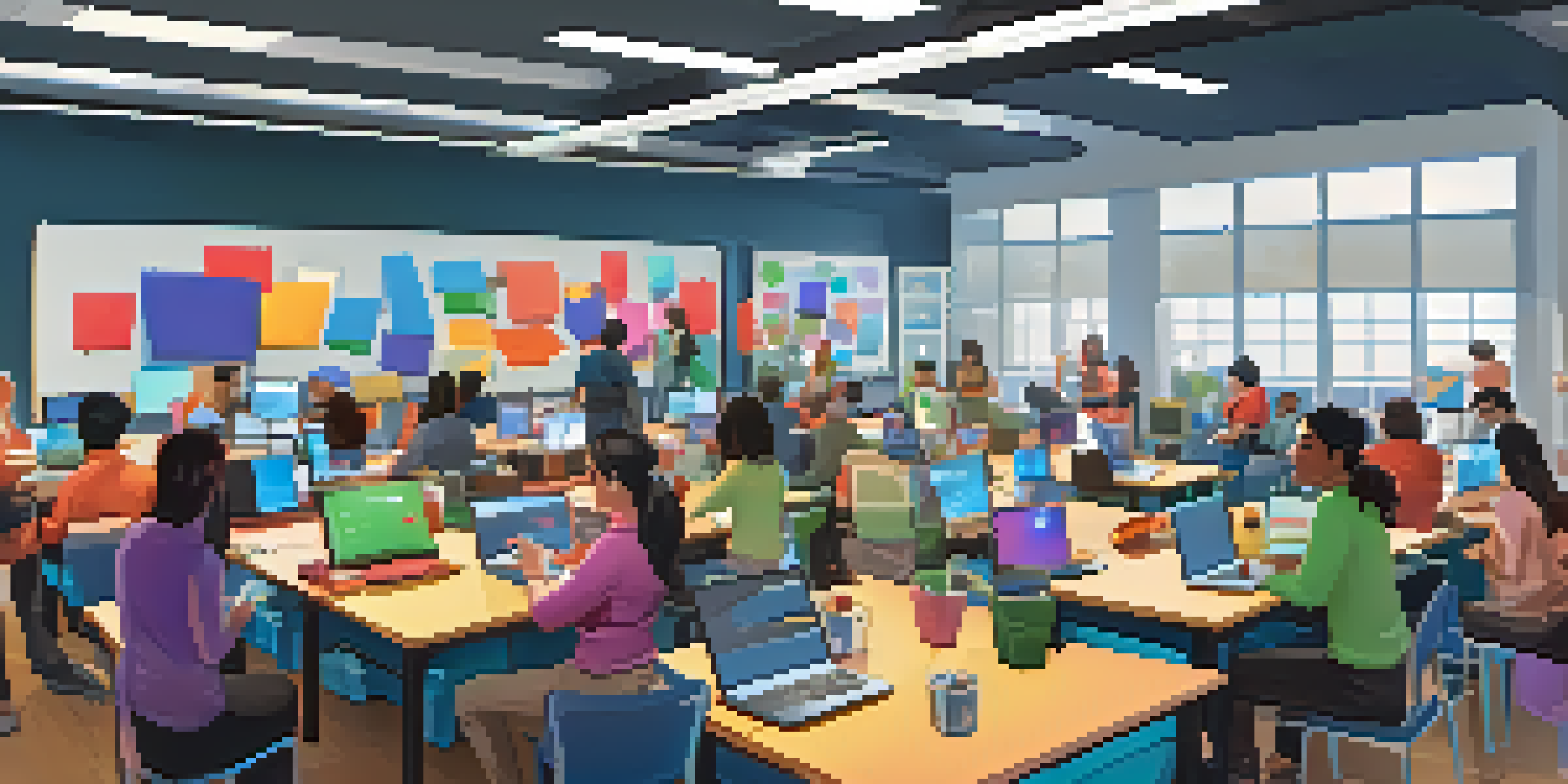Using Gamification to Enhance Adult Learning Experiences

What is Gamification and Why Does it Matter?
Gamification refers to the integration of game elements into non-game contexts, like education. By using concepts such as points, badges, and leaderboards, it transforms the learning experience into something more engaging and enjoyable. This approach taps into our natural desire for competition and achievement, making learning feel less like a chore and more like an adventure.
Gamification is the use of game elements in non-game contexts to engage users and solve problems.
In adult learning, where motivation can occasionally wane, gamification offers a refreshing way to boost interest and participation. For example, a training program that incorporates challenges and rewards can motivate learners to complete modules and retain information better. By framing learning as a game, adults can unlock a sense of playfulness that often gets lost in traditional educational settings.
Moreover, gamification can cater to diverse learning styles, ensuring that everyone finds a way to connect with the material. Whether someone is a visual learner who thrives on interactive graphics or a kinesthetic learner who enjoys hands-on activities, gamification allows for flexibility in learning approaches, enhancing the overall educational experience.
The Role of Competition in Adult Learning
Competition drives many aspects of our lives, from sports to career advancement, and it can be a powerful motivator in learning as well. By introducing competitive elements, such as scoreboards or timed challenges, adult learners feel a sense of urgency and excitement that can push them to engage more deeply with their studies. This competitive spirit can lead to increased focus and retention of information.

However, it's essential to strike a balance; the competition should be friendly and inclusive rather than cutthroat. For instance, team-based challenges can foster collaboration and camaraderie among participants, creating a supportive learning community. This approach not only enhances learning outcomes but also builds relationships that can extend beyond the classroom.
Gamification Engages Adult Learners
By incorporating game elements like points and badges, gamification transforms traditional learning into an engaging experience.
Furthermore, healthy competition can spur self-improvement as learners strive to better their scores or achievements. By setting personal goals and tracking progress, adult learners can experience a sense of accomplishment that fuels their motivation to continue learning and growing.
Incorporating Rewards and Recognition
In the world of gamification, rewards and recognition play a crucial role in keeping learners engaged. Badges, certificates, or even simple shout-outs can make a significant impact on how adults perceive their progress. These tangible symbols of achievement not only boost confidence but can also encourage others to strive for the same recognition.
The greatest reward in learning is not just the knowledge gained but the community built along the way.
For example, an online course could implement a badge system where learners earn awards for completing modules or participating in discussions. This not only incentivizes engagement but also creates a sense of community as learners share their accomplishments. When people feel recognized, they are more likely to remain committed to their learning journey.
Moreover, the anticipation of rewards can drive motivation even further. As learners work towards specific goals, the prospect of earning a coveted badge or recognition can keep them focused and excited about their progress. This element of gamification taps into the psychological principle of reinforcement, making it a powerful tool for adult education.
Fostering Collaboration Through Game Elements
While competition can be motivating, collaboration is equally important in adult learning. Gamification can foster teamwork through activities that require participants to work together to solve problems or complete tasks. This not only enhances learning but also encourages the development of social skills and professional relationships.
For instance, a group project that incorporates game elements, such as scoring points for teamwork or creative solutions, allows learners to collaborate in a fun and engaging way. Participants can share their strengths, learn from each other, and build a sense of belonging within the learning environment. This collaboration can lead to richer discussions and a deeper understanding of the material.
Collaboration Enhances Learning
Gamification fosters teamwork through collaborative tasks, helping adults develop essential social and professional skills.
Additionally, collaborative gamification helps learners develop critical thinking and communication skills that are valuable in the workplace. By navigating challenges together, adults can practice negotiation and leadership skills, preparing them for real-world scenarios where teamwork is essential.
Utilizing Technology to Enhance Engagement
In an age where technology permeates every aspect of our lives, leveraging it in adult learning is essential. Gamification often utilizes digital platforms and tools that make learning more accessible and engaging. From mobile apps to online simulations, technology can provide immersive experiences that traditional methods simply can't match.
For example, online learning platforms that include gamified elements can allow adults to learn at their own pace while still enjoying the benefits of competition and rewards. Interactive quizzes, virtual badges, and leaderboard rankings can create a dynamic learning environment that keeps participants coming back for more. This incorporation of technology not only enhances engagement but also makes learning more convenient.
Furthermore, utilizing technology allows for real-time feedback, enabling learners to track their progress and adjust their strategies accordingly. With instant results from quizzes or challenges, adults can identify areas for improvement and celebrate their successes, creating a more personalized learning experience.
Designing Effective Gamified Learning Experiences
Creating a successful gamified learning experience requires careful planning and design. It's essential to align game elements with learning objectives, ensuring that the gamification enhances the educational content rather than distracts from it. This means understanding your audience and what motivates them to learn.
For instance, if you're designing a training program for healthcare professionals, incorporating case studies and scenarios relevant to their field can make the experience more engaging. By contextualizing game elements within their everyday tasks, you help learners see the practical application of their education. This relevance can significantly increase motivation and participation.
Technology Boosts Learning Engagement
Utilizing digital platforms for gamification enhances accessibility and provides immersive experiences that keep learners motivated.
Additionally, it's crucial to maintain a balance between fun and educational value. Gamification should enhance the learning experience without overshadowing the content itself. By thoughtfully integrating game mechanics, you can create a learning environment that is both enjoyable and conducive to achieving educational goals.
Measuring the Impact of Gamification on Learning
To truly understand the effectiveness of gamification in adult learning, it's vital to measure its impact. This can include assessing engagement levels, knowledge retention, and overall satisfaction with the learning experience. By collecting data through surveys and analytics, educators can gain insights into what works and what needs improvement.
For example, tracking completion rates and participant feedback can provide valuable information on how gamified elements are influencing engagement. If learners report higher motivation levels and improved retention of information, it’s a strong indicator that gamification is making a positive impact. This data can guide future iterations of the program, ensuring that it continues to meet the needs of adult learners.

Moreover, measuring outcomes can help justify the investment in gamification to stakeholders. By showcasing success stories and tangible results, educators can advocate for broader implementation of gamified learning strategies in adult education settings, ultimately enhancing the learning experiences for all involved.